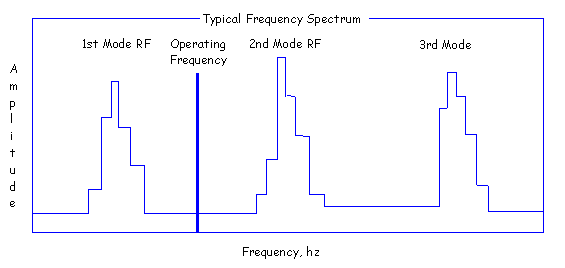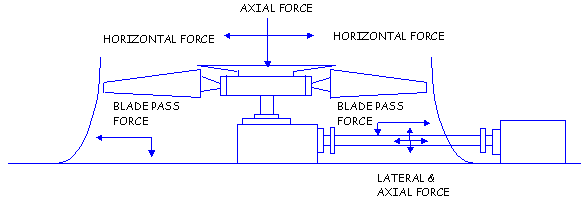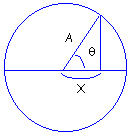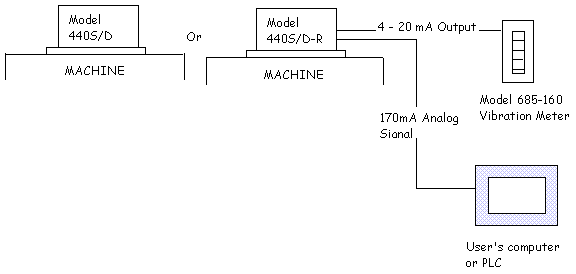|
|
|
|
|
When a body or system is given with an initial displacement from its equilibrium position and is released, it will vibrate with a definite frequency called as the natural frequency. In other word, if you were to suspend a slender article and you begin vibrating it at varying frequencies, beginning at zero hz or at some point it would begin to vibrate dramatically as its resonant frequency (RF) was reached. This is a point where its natural frequency to vibrate was exited by an equal applied source and it would resonate. This is a characteristic of any mass but we are discussing fan blades of any size or type. Additionally, the resonant frequency of an operating fan will be somewhat higher than the measured static natural frequency because of the stiffening effect of centrifugal force. Hudson provides first and second modes of blade natural frequencies. These first mode & second mode resonant frequencies were actually measured on a special vibration mount by a real time analyzer for recording and obtaining them. 2) Fan Dynamic Characteristics Cooling tower fans for the electric utility and petrochemical process industries are used in sizes varying from 12 ft to 60 ft in diameter of cooling tower, with common fan sizes in the 26-30 ft range. Because fan efficiency has become a significant factor in evaluating cooling tower costs, the larger, more efficient fans are usually selected in new applications, often without sufficient regard to such an important factor as fan dynamic response at low speeds. Also, the fan's low operating speeds require special and often unfamiliar equipment for analysis and monitoring. Adherence to a few basic rules during fan selection can greatly reduce this dynamic response and associated fan stresses. Implementation of a regular maintenance program based on vibration trend analysis is also imperative to enable scheduling of preventive maintenance and balancing activities. If a failure is imminent, electronic monitoring devices that respond over an extended frequency spectrum can give warning before severe damages is done to the tower or the fan. To ensure the optimum operating condition of cooling tower fans there are several important things for operating frequencies and resonant frequency margin which have to be carefully considered. Investigation into the dynamic response of a fan blade begins with the determination of the static natural frequency (fs)of the blade. This value can be easily determined for the first mode of vibration by striking the blade and then recording this frequency with a vibration meter. To correct for the effects of centrifugal forces at fan operating speed, this static natural frequency must be converted to dynamic natural frequency (fd). This is done by using the following equation; fd = {(fs)2 + K x RPM}1/2, where fs and fd are both expressed in cycles/min. and K is a constant, whose value is 1.5 for most fans. For most large diameter cooling tower fans the first mode dynamic natural blade frequency is usually much higher than the allowable operational speed of the fan. Limits on fan speed are governed by blade stress and fan noise. This limit is generally considered to be the speed at which blade tip velocity is 12,000 ft/min. Thus, it is rare to find a cooling tower fan speed that is coincident with its blades' first dynamic natural frequency. There are two fan operating frequencies which should be separated from the natural frequency of blade in order to avoid resonance at fan. If the force or displacement is applied with a frequency close to the natural frequency of the system, the amplitude of vibration in a system becomes extremely large. This force or displacement is resonance. As you can see from the definition of the resonance, the vibration amplitude becomes very large as a typical symptom. It is often misunderstood as a fan unbalance problem if there is no vibration analysis capability. However, the resonance problem is a far more dangerous and complex, and the cure can be very expensive requiring either change the motor speed or add blade number. (1) Typical Natural Frequency Spectrum: The peak of natural frequencies on blades are very narrow (2 or 3 hz) due to the fiberglass composite structure requiring less separation than the metal (Aluminum) construction blades. Typical natural frequency spectrum normally follows a signature as below.
As the operating frequency gets close to the center of natural frequency mode, the dynamic stiffness of asystem rapidly decrease compare to the static structural stiffness. This causes the high vibration amplitude. Considering the peak profile characteristics of natural frequency modes and the past experiences, we feel that the minimum separation of 10% away from any natural frequencies is desirable. (2) Fan Operating Frequencies (a) Blade Pass Frequency (BPF): Vibrations that are significant to the cooling tower structure are those thatare induced as multiples of the fan operational speed. These impulse forces or excitation frequencies are functions of the number and order of location of the supporting structures underlying the fan. The basic structural excitation frequency is commonly referred to as the blade pass frequency (BPF) and is calculated by this equation: BPF = No. of Blades x Fan rpm / 60 (hz) This is the frequency where the blades aerodynamically excites the supporting beam or tower structure. If a resonance occurs at this frequency, large vibration will be exhibited at the tower structure. The natural frequency of your tower structures should be away from this frequency. This can be a great destruction of fan blades when the blade passing frequency equals the resonant frequency. The frequency of blade vibration may differ from the BPF if large beams, drive shaft or other obstructions are within about 2 feet from blades. In this case BPF shall be modified by "N" times obstruction. Such as two beams close to the tops may cause a frequency of (2 x BPF) hz. This frequency would have to be compared to the blade's resonant frequency of an exciting force is in harmony with the fan dynamic frequency. Aerodynamic forces generated by blades passing over structural members, lubrication lines, drive shafts, etc. will excite blade vibration at a frequency determined by the number of times per revolution blades pass over obstructions. These critical speed occurs at 2, 3, 4...N cycles per revolution frequency depending on the number of obstructions. Best results will be obtained if this basic excitation frequency is kept at least three times as high as the fan blade natural dynamic frequency. Equally importance is the associated components of the cooling tower, such as drivelines, fan stacks, beams, etc. which must be tuned to avoid resonance with this basic BPF. Problems encountered with BPF resonance are usually destructive, and merit immediate attention. One solution is to change the natural frequency response of the components or blades, another is to change the BPF. Changing the BPF can be done by varying either the fan speed or the blade number. Because the later solution involves considerable expense in fan or gear change out, the more practical solution is usually to tune and damp the tower structure by bracing or weighting the individual components. This will help control vibrations induced by the fan relative to the structure. While necessary to prevent structural problems, measurement of vibration levels on the cooling tower structures tells little about the fan blade itself and its position in the air it is moving. For this reason, wave front analysis techniques have been developed that use telemetry systems to provide stress and acceleration data from the blades as they transit the throat of the fan stack. Frequency spectrum or signature analysis of these data has consistently revealed that these fans experience impulses at all fundamental harmonics of the operating speed. These excitation forces are created by wave front in the air flow due to the structural patterns found in the plenum directly below the fan. Structural obstructions include wood, concrete, or steel beams, piping conduit, and wind walls. The effect obstructions have on the air flow is to create dead spots or wave fronts where the air direction is changed or is turbulent. These wave front occur in mathematical series similar to the geometric patterns of the obstructions creating them. As a fan blade makes a revolution, it encounters air loading impulses - excitation forces - in a periodic function that can constitute integral multiples of the operating speed. Therefore, the fan blade's natural dynamic frequency (fd) must not coincide with any multiple of fan rpm. When selecting fan operational speed it is also important to consider the expected variance in the dynamic natural frequency from blade to blade. If, for example, 28 ft diameter blade's natural frequency were to vary +/- 4%, the possibility of encountering a critical frequency situation is significant. Note that the excitation frequency responses at integral multiples of fan rpm can greatly restrict the speeds at which the blade can operate given the variance in its natural dynamic frequency. Good engineering practice dictates that these potential driving forces at integral multiples of rpm be kept at a critical range of at least 10% away from the natural frequencies of the fan blades, to avoid resonant amplifications of forces. Because the fan must avoid all multiples of fan rpm, the critical range should be calculated for (N = 1, 2, 3, ...) using this equation: CR = (N x RPM - fd) / rpm x 100. Due to these dynamic characteristics, large diameter cooling tower fans are not suitable for variable speed service. Programs that attempt to conserve energy by proposing that fans be driven at variable speeds run the risk of encountering severe vibration problems. In such an installation, the cooling tower's plenum chamber would have to be relatively free of flow disruptive structures. Fan blades with high damping factors would also be required, to resist the amplification of forces. If conservation of fan energy is required, the best approach is use of a two speed electric motor. This will provide no problem, because fans that are operating at full speed in safe critical frequency ranges will automatically be in the same ranges at half speed. Variable pitch fans are also an acceptable method of controlling fan flow and energy, and this is the method that is recommended in cases where a precise level of fan throttling is needed. (b) Beam Pass Frequency: This is the frequency where the aerodynamic effect of the beam occurs to fan blade and is obtained from an equation of Beam Pass Frequency = No. of Beam x Fan rpm / 60 (hz). If a resonance occurs at this frequency, the blade might be damaged at its mode(s) depending on the mode type (i.e. first or second mode) where the excitement force coincides at. In normal cases, this frequency is less important since the RF margin exceed the minimum 5%, but there is often a case to carefully consider the RF margin in case of small number of fan blades. |





